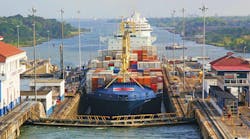Download this article in PDF format.
Drought conditions and attacks on container ships are impacting shipping and supply chains right now in two of the world’s most critical waterways. Both the Panama and Suez Canals are experiencing issues that may delay shipments—shipments that are having to be re-routed to longer routes extending south of South America or Africa, respectively.
According to Air Cargo News, shipping companies have rerouted vessels away from the Suez Canal in Egypt following attacks on container ships in the Red Sea, off the Yemen coast. These attacks have been carried out by the Houthi Militia in response to Israel’s military operations in Gaza. “Companies are now considering a costly and time-consuming alternative route around Africa via the Cape of Good Hope,” the publication explains.
S&P Global says three liquefied natural gas (LNG) carriers looking to transit the Suez Canal have diverted to longer routes as attacks by Houthi rebels in the region pushed a change in transit flows, including a tanker carrying a shipment from the Freeport LNG terminal in Texas. “Attacks by the Iran-backed Houthi militants on ships passing through the Bab al-Mandab Strait and the Red Sea have surged recently, adding security risks to ships passing through the Suez Canal,” the publication adds.
Flowing as Normal
Reuters says the Suez Canal is used by roughly one-third of global container ship cargo, and that redirecting ships around the southern tip of Africa is expected to cost up to $1 million extra in fuel for every round trip between Asia and Northern Europe.
For now, navigation through the Suez Canal is “flowing as normal,” S&P Global reports, and the Suez Canal Authority is watching the ongoing tensions in the Red Sea and assessing the impact on shipping.
Governments are currently considering measures to address the Red Sea danger, Air Cargo News reports, and an international task force has been set up that will share ships and other resources. Participating countries include the U.S., U.K., Bahrain, Canada, France, Italy, Netherlands, Norway, Seychelles and Spain.
Navigating Restrictions in Panama
The shipping industry is also navigating restrictions on vessels passing through the Panama Canal set by the Panama Canal Authority because of reduced water levels due to drought. The number of ships allowed to pass through the route each day is currently down to 22 from the usual 36 ships per day, which has also caused delays within the global supply chain, Air Cargo News reports.
The situation in Panama may already be improving. “However, while the restrictions were set to become stricter with ships to be limited to 18 by February of next year, rainfall and lake levels have been higher than expected, meaning the Panama Canal Authority recently decided it will increase the number of daily transits to 24 starting in January.”
Both the Suez and Panama Canal routes have few viable alternatives. In fact, these two crucial waterways accounted for over half of the container shipping by volume scheduled between Asia and North America in the third quarter, Financial Times reports. “This means authorities must invest in the resilience of key trading chokepoints, both in terms of their security and climate adaptability,” it continues, “and by improving port efficiency and alternative transport routes.”








